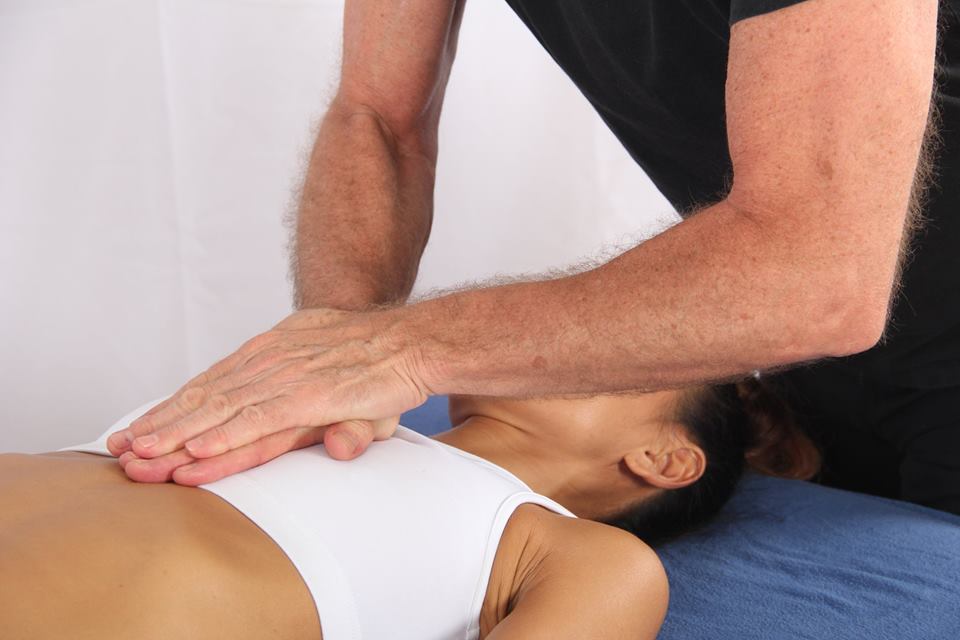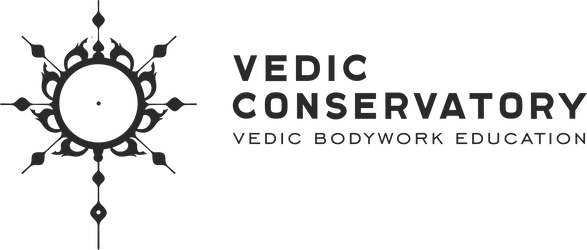
BREATH COMPRESSIONS
Palm over Palm
As we open our eyes after meditation, we observe the receiver’s breathing. We can then place our palms, one over the other, upon the center of the receiver’s chest at the sternal-manubrial notch. Remember to place one foot far enough behind you for support so that you can lift your front foot upwards to gently yet firmly displace your weight onto the receiver’s chest. Instruct the receiver to exhale with a sigh of relief. The sound of this sigh will add to the quality of the application so encourage the receiver to emote a sigh of relief. Upon the exhale seamlessly, join in with rapid and rhythmic pumping to the torso cavity. Use staccato like bursts of energy, with a direct perpendicular trajectory to the chest, to assist the receiver in expiring their air. It is important to instruct the receiver to not force out their air but to allow it to ‘tumble’ out. We don’t want the intercostals muscles to contract because this would be counter-productive to our intention. Repeat this procedure several times by alternating one hand upon the other.
Prayer Mudra
Using the same stance as the palm over palm procedure, place the palms together in a prayer gesture and place them again upon the same sternal-manubrial notch. Instruct the receiver again to take a deep wholesome breath. Upon the exhale, pump the area with gentle yet explosive compressions using the padded part of the hypo-thenar eminences. Repeat this prayer mudra breath compression several times. Please remember to NOT lift your hands off the receiver. Be in contact the entire procedure otherwise that application would be considered a Prayer Chop Percussion stroke which is inappropriate and discourteous at that time and location. Also, always remember to not stretch the skin towards the feet or in any other trajectory save directly perpendicular and into the chest center. There are several breath compression applications to utilize. These two are fundamental and deeply rewarding to offer at any time during the treatment.
SHOULDER CHAKRAS
For this third type of breath compression, maintain the same bodily stance. Place the heels of your palms upon the pectoral fossas, the pectoral’s basin like indentations just below the clavicles. In acupuncture this area is the location of lung #1 and #2. needle points. It is essential to connect the heels of your palms with the receiver’s rib cage and not just the soft tissue. Again we instruct the receiver to take a deep breath and upon the exhalation, assist the receiver with firm, rhythmic and synchronized rotations of our palms to the chest cavity. In order to avoid any discomfort to the receiver, it is imperative that our palms rotate in the same direction. Rotating the palms in opposite directions will cause major discomfort due to stretching the skin. Be sure to be vigorous enough that you see the entire body responding in a sinuous wave all the way to the feet. Repeat this procedure again rotating your palms in the other direction. When offered correctly, this procedure is very pleasurable and satisfying.
CAUTIONS: *Always inform the recipient of the nature of this application.
*If the sternal-manubrial notch area is hyper-sensitive, palpate the area first with gentle finger circles to empty it of built up lymphatic fluid and metabolic crystallization deposits.
*Acute lung imbalances
*Recent heart/chest surgery
BENEFITS: *Increased Breath Volume and Oxygenation.
*Stimulated Thymus Gland
*Released Adhesions from intercostals muscles.
*Stimulated Cystern Chiele/Lymphatic Pumping.
*4th Chakra Balancing-Emotional Openings
*5th Chakra Opening-Clear /Expressive Communications.


Leave a comment